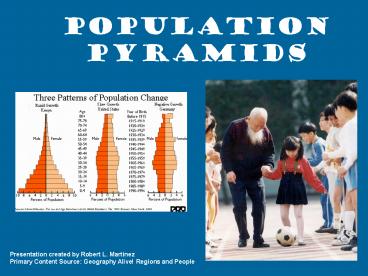Population Pyramids - PowerPoint PPT Presentation
1 / 27
Title:
Population Pyramids
Description:
Presentation created by Robert L. Martinez Primary Content Source: Geography Alive! Regions and People Population Pyramids demography The study of human populations ... – PowerPoint PPT presentation
Number of Views:121
Avg rating:3.0/5.0
Title: Population Pyramids
1
Population Pyramids
Presentation created by Robert L.
Martinez Primary Content Source Geography Alive!
Regions and People
2
demography
- The study of human populations, including how
they change due to births, deaths, aging, and
migration.
3
Europe is one of the smallest continents in size,
but about an eight of the worlds people live
there.
4
This high population density may not hold steady
much longer for two reasons. First, Europe has
the oldest population of any continent.
5
Second, it has the lowest birth rate, or number
of births per 1,000 people of any continent. As a
result the population is shrinking.
6
The study of population trends focuses on three
factors births, deaths, and migration. Whether a
population grows or shrinks depends on the
trends of these factors.
7
Children are born every day in Europe, but the
average number of babies born to each woman is
low. This average number of births is called the
total fertility rate.
8
Total Fertility Rate
- The average number of children a woman in a given
population will have in her lifetime. This number
is different in different countries.
9
In 2000, the Total Fertility Rate in Italy was
just over one baby per woman. If the Total
Fertility Rate remains this low, Italys
population will continue to shrink.
10
To stop this trend, the Total Fertility Rate
would need to rise to the replacement rate.
11
Replacement Rate
- The total fertility rate needed for a population
to replace itself. This number varies by country,
but is about 2.1 in most developed countries.
12
This rise will occur when enough babies are born
to replace the people who die each year. In
Italy, the replacement rate is just over two
babies per woman.
13
People also die every day in Europe, but they
dont die as young as they used to. Over the past
century, life expectancy, or the number of yeas a
person can expect to live, has increased in
Europe.
14
Life Expectancy
- The average age that a person in a given
population can expect to live to. Life expectancy
varies from one country to another.
15
In 2004, the average person in France could
expect to live about 80 years. A century earlier,
life expectancy in France was only 50 years.
16
People move into and out of Europe every day as
well. In the past, most migration was out of
Europe, as people left to escape wars and poverty.
17
Today more people are migrating into Europe than
are leaving it. Still, there are not enough
immigrants arriving to keep Europes population
stable.
18
Geographers use graphs shaped like pyramids to
study population. These graphs show the ages and
sexes in a population, with the youngest ages
shown at the bottom and the oldest at the top.
19
The shape of a population pyramid shows how a
countrys population is growing .
20
A pyramid that is wide at the bottom shows rapid
population growth. More babies are being born
each year than the number of people who die.
21
A pyramid with straight sides shows slow
population growth, with births and deaths nearly
equal in that country.
22
A pyramid that is narrow at the bottom shows
negative population growth. More people are dying
each year than are being born.
23
Population growth affects a countrys dependency
ratio. This ratio compares the number of people
too young or too old to work with the countrys
working-age population.
24
Dependency ratio
- The number of old and young dependents who dont
work compared with the working-age population.
The higher the ratio, the more young and old
people the workers have to support.
25
In Europe, most young people under the age of 16
dont work, and most people over the age of 64
are retired.
26
Both groups depend on other people to support
them. A low dependency ratio means that workers
have few dependents to support.
27
A high dependency ratio means just the opposite,
that there are a lot of young or old people for
workers to support. Europe is experiencing
problems due to their high dependency rate.































